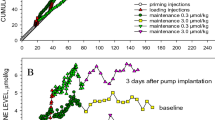Abstract
The locomotor stimulant effects of sustained administration of a potent and selective dopamine (DA) D-2 receptor agonist, [+]-4-propyl-9-hydroxynaphthoxazine (PHNO), in rats were assessed 24 h a day during 12 h light-dark cycles. PHNO was administered continuously with subcutaneous implants of Alzet osmotic minipumps (5 μg/h), for 12 h a day with modified osmotic minipumps (5 μg/h), or by daily injections (15 μg, SC). Tolerance was observed to occur only with 24 h continuous infusions and only during the light period. The other treatment regimens produced sensitization of the locomotor response. Daytime tolerance to continuous infusions of PHNO was reversed following reversal of the light-dark cycle. A normally ‘arousing’ stimulus also reversed (temporarily) daytime tolerance. The present results indicate that the temporal pattern of administration of DA agonists, the phase of the circadian cycle and environmental stimuli associated with arousal are important determinants of the behavioral consequences of long-term treatment.
Similar content being viewed by others
References
Antelman SM, Chiodo LA (1983) Amphetamine as a stressor. In: Creese I (ed) Stimulants: neurochemical, behavioural and clinical perspectives. Raven Press, New York, pp 269–299
Antelman SM, Szechtman H, Chin P, Fisher AD (1975) Tail pinch-induced eating, gnawing and licking behaviour in rats: dependence on the nigrostriatal dopamine system. Brain Res 99:319–377
Breese GR, Mueller A (1985) SCH-23390 antagonism of a D-2 dopamine agonist depends upon catecholaminergic neurons. Eur J Pharmacol 113:109–114
Castro R, Abreu P, Calzadilla CH, Rodriguez M (1985) Increased or decreased locomotor response in rats following repeated administration of apomorphine depends on dosage interval. Psychopharmacology 85:333–339
Eichler AJ, Antelman SM, Black CA (1980) Amphetamine stereotypy is not a homogenous phenomenon: sniffing and licking show distinct profiles of sensitization and tolerance. Psychopharmacology 68:287–290
Eison MS, Eison AS, Iversen SD (1983) Two routes of continuous amphetamine administration induce different biochemical and neurochemical effects in the rat. Neurosci Lett 39:313–319
Grimes JD, King DB, Kofman OS, Molilna-Negro P, Wilson AF, Bouchard S (1984) Bromocriptine in the management of end of dose deterioration in Parkinson's disease. Can J Neurol Sci 11:452–456
Guttman M, Seeman P (1985) l-Dopa reverses the elevated density of D2 dopamine receptors in Parkinson's diseased striatum. J Neural Transm 64:93–103
Hardie RJ, Lees AJ, Stern GM (1984) On-off fluctuations in Parkinson's disease. Brain 107:487–506
Hess EJ, Alberts LH, Le H, Creese I (1986) Effects of chronic SCH 23390 treatment on the biochemical and behavioural properties of D1 and D2 dopamine receptors: potentiated behavioural responses to a D2 dopamine agonist after selective D1 dopamine receptor upregulation. J Pharmacol Exp Ther 238:846–854
Jackson DM, Hashisume M (1986) Bromocriptine induces marked locomotor stimulation in dopamine-depleted mice when D-1 receptors are stimulated with SKF 38393. Psychopharmacology 90:147–149
Jackson DM, Jenkins OF (1985) Hypothesis: bromocriptine lacks intrinsic dopamine receptor stimulating properties. J Neural Transm 62:219–230
Jankovic J (1985) Long-term use of dopamine agonists in Parkinson's disease. Clin Neuropharmacol 8:131–140
Kokkinidis L (1984) Effects of chronic intermittent and continuous amphetamine administration on acoustic startle. Pharmacol Biochem Behav 20:367–371
Lieberman AN, Goldstein M (1982) Treatment of advanced Parkinson's disease with dopamine agonists. In: Marsden CD, Fahn S (eds) Movement disorders. Butterworth Scientific, London, pp 123–145
Marsden CD, Fahn S (1982) Problems in Parkinson's disease. In: Marsden CD, Fahn S (eds) Movement disorders. Butterworth Scientific, London, pp 1–7
Martin GE, Williams M, Pettibone DJ, Yarbrough GG, Clineschmidt BV, Jones JH (1984) Pharmacologic profile of a novel potent dopamine agonist (+)-4-propyl-9-hydroxynaphthoxazine [(+)-PHNO]. J Pharmacol Exp Ther 230:569–576
McCall RB, Appelbaum MJ (1973) Bias in the analysis of repeated-measures designs: some alternative approaches. Child Dev 44:401–415
Mereu G, Muntoni F, Calabresi P, Romani F, Boi V, Gessa GL (1986) Responsiveness to ‘autoreceptor’ doses of apomorphine is inversely correlated with the firing rate of dopaminergic A9 neurons: action of baclofen. Neurosci Lett 65:161–166
Molloy AG, O'Boyle KM, Pugh MT, Waddington JL (1986) Locomotor behaviours in response to new selective D-1 and D-2 dopamine receptor agonists, and the influence of selective antagonists. Pharmacol Biochem Behav 25:249–253
Nelson LR, Ellison G (1978) Enhanced stereotypies after repeated injections but not continuous amphetamines. Neuropharmacology 17:1081–1084
Nielsen EB (1981) Rapid decline of stereotyped behavior in rats during constant one week administration of amphetamine via ALZET osmotic minipumps. Pharmacol Biochem Behav 15:161–165
O'Neill RD, Fillenz M (1985) Simultaneous monitoring of dopamine release in rat frontal cortex, nucleus accumbens and striatum: effect of drugs, circadian changes and correlations with motor activity. Neuroscience 16:49–55
Parenti M, Flauto C, Parati E, Vescoui A, Goppetti A (1986) Differential effect of repeated treatment with l-dopa on dopamine D-1 or D-2 receptors. Neuropharmacology 25:331–334
Post RM (1980) Intermittent versus continuous stimulation: effect of time interval on the development of sensitization or tolerance. Life Sci 26:1275–1282
Quinn N, Parkes JD, Marsden CD (1984) Control of on/off phenomenon by continuous intravenous infusion of levodopa. Neurology 34:1131–1136
Rinne UK (1983) Problems associated with long-term levodopa treatment of Parkinson's disease. Acta Neurol Scand [Suppl] 95:19–26
Rinne JO, Rinne JK, Laakso K, Lonnberg P, Rinne UK (1985) Dopamine D-1 receptors in the Parkinsonian brain. Brain Res 359:306–310
Robinson TE, Becker JB (1986) Enduring changes in brain and behaviour produced by chronic amphetamine administration: a review and evaluation of animal models of amphetamine psychosis. Brain Res Rev 11:157–198
Tilson HA, Rech RH (1973) Conditioned drug effects and absence of tolerance to d-amphetamine-induced motor activity. Pharmacol Biochem Behav 1:149–153
Zetterstrom T, Sharp T, Ungerstedt U (1986) Effect of dopamine D-1 and D-2 receptor selective drugs on dopamine release and metabolism in rat striatum in vivo. Naunyn-Schmiedeberg's Arch Pharmacol 334:117–124
Author information
Authors and Affiliations
Rights and permissions
About this article
Cite this article
Martin-Iverson, M.T., Stahl, S.M. & Iversen, S.D. Chronic administration of a selective dopamine D-2 agonist: factors determining behavioral tolerance and sensitization. Psychopharmacology 95, 534–539 (1988). https://doi.org/10.1007/BF00172969
Received:
Revised:
Issue Date:
DOI: https://doi.org/10.1007/BF00172969




